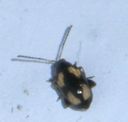Striped Flea Beetle
Phyllotreta striolata
Classification
- Phylum: Arthropoda
- Subphylum: Hexapoda
- Class: Insecta
- Order: Coleoptera
- Suborder: Polyphaga
- Superfamily: Chrysomeloidea
- Family: Chrysomelidae
- Subfamily: Galerucinae
- Tribe: Alticini
- Genus: Phyllotreta
- Species: striolata
Pronunciation
How to pronounce Phyllotreta striolata: /ˌfɪloʊˈtriːtə ˌstraɪəˈleɪtə/
These audio files are automatically generated. While they are not always 100% accurate, they are a good starting point.
Images






Summary
Phyllotreta striolata, commonly known as the striped flea beetle, is a small pest of brassicas, known for its shiny black body and distinctive yellow markings on its elytra. It primarily damages young plants by feeding on leaves, and its larvae inhabit the soil where they feed on roots. Effective management includes cultural practices, resistant plant varieties, and biological control methods.
Physical Characteristics
2.1-2.5 mm long, elongate oval shape, shiny black with greenish tinge; elytra marked with yellow wavy line; basal three antennae segments yellow-brown; head, pronotum and elytra closely punctate with substriate punctures.
Identification Tips
Look for shiny black beetles with a greenish tinge and a distinctive wavy amber line on the elytra. The beetles are small, measuring about 1.5 to 2.5 mm in length.
Habitat
Commonly found in areas where brassicas are grown, both in cultivated fields and weedy habitats.
Distribution
Eurasian in origin, now widespread across North America (excluding much of the Rocky Mountain region) and present in South Africa.
Diet
Adults primarily feed on the foliage of host plants, causing small round pits in leaves and cotyledons. Larvae feed on the roots of host plants but are not significant pests.
Life Cycle
Eggs are laid in the soil near host plants; larvae hatch and feed on roots for about 3 to 4 weeks, then pupate for 7 to 10 days before emerging as adults. Generations can occur continuously in warmer climates.
Reproduction
Eggs are deposited in soil near the host plants.
Predators
Parasitoids such as braconid wasps (e.g., Microtonus spp.) and biological control agents like nematodes (Steinernema spp.).
Ecosystem Role
Acts as a pest of Brassica crops, contributing to the ecological interaction between pests and plants.
Economic Impact
Considered a pest, particularly of brassicas; can cause significant damage to young plants.
Collecting Methods
- Handpicking from plants
- Traps baited with attractants
Preservation Methods
- Ethanol preservation
- Pinning specimens
Misconceptions
Some may confuse it with other flea beetles, but its distinct coloration and markings differentiate it.
Tags
- beetle
- pest
- Brassica
- agriculture
- insect pest